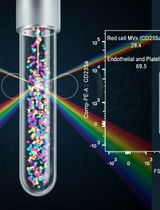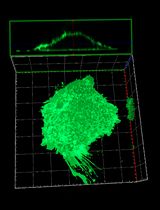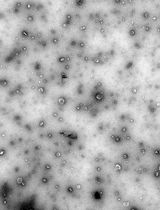- EN - English
- CN - 中文
Generation of Giant Unilamellar Vesicles (GUVs) Using Polyacrylamide Gels
使用聚丙烯酰胺凝胶生成巨型磷脂囊泡(GUVs)
发布: 2020年11月05日第10卷第21期 DOI: 10.21769/BioProtoc.3807 浏览次数: 4737
评审: David PaulPhilipp A.M. SchmidpeterAnonymous reviewer(s)

相关实验方案

外周血中细胞外囊泡的分离与分析方法:红细胞、内皮细胞及血小板来源的细胞外囊泡
Bhawani Yasassri Alvitigala [...] Lallindra Viranjan Gooneratne
2025年11月05日 1326 阅读
Abstract
Giant unilamellar vesicles (GUVs) are a widely used model system for a range of applications including membrane biophysics, drug delivery, and the study of actin dynamics. While several protocols have been developed for their generation in recent years, the use of these techniques involving charged lipid types and buffers of physiological ionic strength has not been widely adopted. This protocol describes the generation of large numbers of free-floating GUVs, even for charged lipid types and buffers of higher ionic strength, using a simple approach involving soft polyacrylamide (PAA) gels. This method entails glass cover slip functionalization with (3-Aminopropyl)trimethoxysilane (APTES) and glutaraldehyde to allow for covalent bonding of PAA onto the glass surface. After polymerization of the PAA, the gels are dried in vacuo. Subsequently, a lipid of choice is evenly dispersed on the dried gel surface, and buffers of varying ionic strength can be used to rehydrate the gels and form GUVs. This protocol is robust for the production of large numbers of free-floating GUVs composed of different lipid compositions under physiological conditions. It can conveniently be performed with commonly utilized laboratory reagents.
Keywords: Giant unilamellar vesicle (巨型磷脂囊泡)Background
While gentle hydration and electroformation are two of the most commonly used methods for giant unilamellar vesicle (GUV) formation, there are only a few studies that report their use for charged lipid types and in buffers of physiological ionic strength (Stein et al., 2017; Lefrançois et al., 2018). In 2009, Horger and colleagues described a simple gel-assisted swelling method for GUV generation that utilized a hybrid film of agarose gel and lipids. Unlike many other techniques, this method is capable of producing GUVs in buffers of physiological ionic strength and with charged lipid types (Horger et al., 2009). However, it was later determined that the agarose was incorporated into the GUVs, thereby affecting their mechanical properties (Lira et al., 2014). While other methods using poly(vinyl alcohol) (Weinberger et al., 2013) or dextran(ethylene glycol) (López Mora et al., 2014) have successfully developed GUVs without the incorporation of the gel into the vesicle membrane, they have not been widely utilized; this is likely due to the relatively uncommon reagents required. In our recent report (Parigoris et al., 2020), we describe another facile gel-assisted swelling method using soft polyacrylamide (PAA) gels. This technique can generate GUVs composed of both neutral and charged lipids, and under conditions of physiological ionic strength. Like the agarose gel method proposed by Horger et al. (2009), our method utilizes common chemicals present in most laboratories, and to our knowledge, does not encapsulate PAA monomers inside of the vesicles.
Materials and Reagents
5, 10, and 25 ml serological pipettes
30 mm diameter glass cover slips, round, Menzel Glaser #1 (VWR, catalog number: 631-1347 )
150 mm diameter circular Petri dishes (Fisher Scientific, catalog number: FB0875714 )
15 ml conical tubes (Corning, catalog number: 352095 )
50 ml conical tubes (Corning, catalog number: 352070 )
6-well plates (Corning, catalog number: 3516 )
Pipette tips (Appropriate for P1, P10, P20, P100, and P1000 micropipettes)
Parafilm (Sigma, catalog number: P7793 )
Large glass plate (Approximately 200 mm x 200 mm square, or larger)
Glass Drigalski spatula (can be created by melting a glass Pasteur pipette)
Razor blades
Aluminum foil
100% ethanol (Sigma, catalog number: 51976 )
Milli-Q water
Phosphate buffered saline (PBS), pH 7.4 (Thermo Fisher Scientific, catalog number: 10010001 )
Chloroform (Sigma, catalog number: C2432 )
Methanol (EMD Millipore, catalog number: 1060092500 )
(3-Aminopropyl)trimethoxysilane (Sigma, catalog number: A3648 )
Glutaraldehyde (Sigma, catalog number: G6257 )
40% acrylamide solution (Sigma, catalog number: A4058 )
2% N,N′-Methylenebisacrylamide solution (Sigma, catalog number: M1533 )
N,N,N,N-tetramethylethylenediamine (TEMED) (Bio-Rad, catalog number: 1610800 )
Ammonium persulfate (APS) (Sigma, catalog number: A3678 )
1,2-dioleoyl-sn-glycero-3-phosphocholine (DOPC) lipids (Avanti, catalog number: 850375 )
1,2-dipalmitoyl-sn-glycero-3-phosphoethanolamine-N-(lissamine rhodamine B sulfonyl) (Rhod-PE) lipids (Avanti, catalog number: 810158 )
Equipment
Tweezers (Fisher Scientific, catalog number: 12-000-122 )
Set of micropipettes (P1, P10, P20, P100, and P1000)
Pipet-Aid
Orbital shaker
Oven/incubator (capable of maintaining 45 °C)
Desiccator/vacuum
Vortex
Microscope with phase contrast and/or epifluorescence capabilities (Nikon, model: TS100 )
Plasma oxidizer (Diener Elektronic, FEMTO)
4 °C fridge
-20 °C freezer
Procedure
文章信息
版权信息
© 2020 The Authors; exclusive licensee Bio-protocol LLC.
如何引用
Parigoris, E., Dunkelmann, D. L. and Silvan, U. (2020). Generation of Giant Unilamellar Vesicles (GUVs) Using Polyacrylamide Gels. Bio-protocol 10(21): e3807. DOI: 10.21769/BioProtoc.3807.
分类
生物化学 > 脂质 > 膜脂
细胞生物学 > 细胞器分离 > 胞外囊泡
您对这篇实验方法有问题吗?
在此处发布您的问题,我们将邀请本文作者来回答。同时,我们会将您的问题发布到Bio-protocol Exchange,以便寻求社区成员的帮助。
Share
Bluesky
X
Copy link













